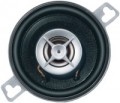The term "impedance" refers to the electrical resistance of AC systems whose DC resistance is very low, such as loudspeakers. In modern car audio, the most common impedance is
2,
4 or
8 ohms. This parameter has practically no effect on the sound quality — it serves to select the optimal combination of acoustics and an external amplifier. If the speaker impedance is higher than that for which the amplifier is designed, the sound will be quieter than necessary, and if the impedance is lower, distortion in the sound is possible.
Size of the low-frequency speaker(s) provided in the speaker system.
This size is specified only for models with separate bass speakers. In such acoustics, it is the LF emitter that is the largest (this is due to the physical characteristics of the bass range). Accordingly, the space occupied by the entire system is determined mainly by the diameter of the LF speaker. And since the power and richness of the bass also directly depends on the size of the emitter, then when choosing, you have to proceed from a compromise between the capabilities of the acoustics and the available space in the car.
The mounting depth of car audio is, in fact, the size of the speaker in depth. Note that for component sets (see "Type") this parameter is given for the largest speaker, and for case models it is generally irrelevant.
The mounting depth, along with the diameter of the speaker (see above), determines the amount of space needed to mount the speaker — in this case, how deep a niche would be required for normal mounting. At the same time, the larger the speaker, the larger, usually, the installation depth. And with similar diameters of equal size, a more powerful model is likely to be more “deep”.
The smallest amount of space —
up to 15 mm deep — is required by some tweeters. A depth
of 16 – 30mm is normal for tweeters and very shallow for general range speakers, most of these models have a depth
of 30mm or more. At the same time, full-range speakers are usually "recessed" by
less than 60 mm, component systems — by
less than 90 mm, and
more depth may be required only for some coaxial and mid-range models and, oddly enough, tweeters.

